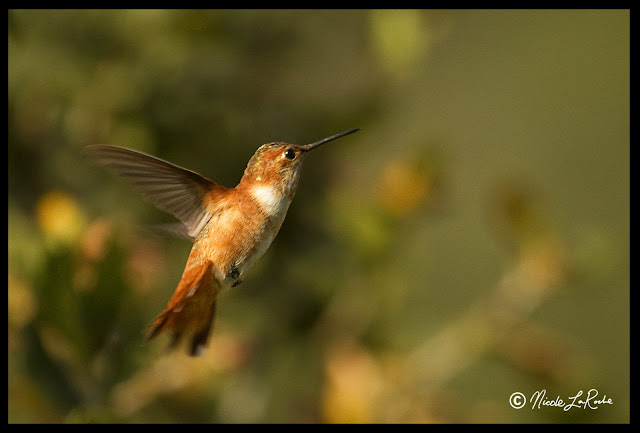Here is the second batch of hummingbird photos. These are from Saturday (3/12) afternoon. I almost filled my 16GB card that day, so editing and choosing my favorites was HARD! Like Thursday's photos, these are Anna's (
Calypte anna), Allen's (
Selasphorus sasin) and Rufous (
Selasphorus rufus) hummingbirds. The Rufous and Allen's are nearly impossible to tell apart, in some cases I was able to make an educated guess and in other cases it was impossible to tell.
These photos have the same photo stats as the last set of hummingbird photos which is: Canon 7D with 100-400L lens, shooting at ISO 400 and F5.6.
The first set of photos is a really cool event that I did not know about until talking to Feynner this weekend. (And you people thought I knew Everything about hummingbirds!!) The female hummingbirds, I mostly saw Anna's but did see a few orange hummingbirds too, will eat ashes. Feynner said he only observes it during the later winter/ early spring, i.e. nesting time, and suspected that it helps the females produce eggs. I was very curious and looked up some published papers about it and there have been studies that show females (of many species of hummingbirds) will eat ashes during nesting time to get needed minerals. Wood ash is rich in calcium, which could be helpful in egg production. One paper stated that the nesting time is a "high stress" time for females and they loose more nutrients while stressed therefore must consume ashes to regain the lost minerals. So, the next few photos are of female Anna's going up to Feynner's ash pile to eat some ashes. I also took some video (I am an amateur with the video function on my 7D but I think they came out pretty well).
 |
| An Anna's hummingbird with a little ash left on her bill |
 |
| A female Anna's with her tongue out |
 |
| Another Anna's with her tongue out, you can see the ash on her tongue! (this is one of my favorites) |
 |
| Two female Anna's fighting over the ashes |
 |
| Two female Anna's fighting over the ashes (another one of my favorites!) |
|
|
The next group of photos is a mixture of different hummingbirds in the oak tree they like near the feeders.
 |
| Three female Anna's hummingbirds |
 |
| Two female Anna's hummingbirds |
 |
| Because of the green on this male's back I would say this is an Allen's, but there also appears to be a notch in the tail feather and that would mean it is a Rufous with a green back (up to 5% of recorded Rufous have slightly green backs). |
 |
| This bird is un-ID-able. It could be Rufous or Allen's. |
 |
| Male Rufous, another one of my favorites! |
 |
| I think this is a male Rufous but am not 100% sure. |
 |
| Male Rufous hummingbird |
 |
| Wait, it's not a hummingbird! This is a dark-eyed junco with something odd on its cheek |
The last set of photos is the hummingbirds visiting a Jade bush (Crassula ovata) near the feeder. Jade plants are not native to this area, they are originally from South Africa. They are very popular houseplants because they are easy to maintain. They have small flowers, but the hummingbirds seem to love them, which may just be because it is very close to the feeders.
 |
| A male Anna's hummingbird using a makeshift post while feeding at the Jade bush. |
 |
| A male Rufous hummingbird |
 |
| A male Anna's and a female/immature Allen's sharing the Jade bush |
 |
| This is kind of like a where's Waldo, there are 3 hummingbirds here, two male Anna's and an Allen's. Can you find them all? |
 |
| Anna's and Allen's sharing at the Jade bush |
 |
| An Allen's hummingbird (either female or immature male) |
When you thought it would never end, it finally (sadly) does. Don't worry, these little guys are a short hike away for me and there will be many more photos in the future!





















how the quality of the video function? Haven't seen any video from them except dpreview review of 5D mark II video function.
ReplyDelete